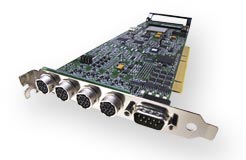|
||||||||||||||||||||||||||||||||||||||||||
|
||||||||||||||||||||||||||||||||||||||||||
 X64-AN
Quad
X64-AN
Quad
Back to Analogue
Frame Grabbers
Back to Teledyne DALSA Frame Grabbers
When the need is to deliver concurrent
image acquisition
The X64-AN Quad is a high-performance PCI-X bus compatible frame grabber,
designed to deliver concurrent image acquisition from multiple independent
standard and progressive scan analog cameras.
Image Acquisition
The X64-AN Quad is capable of grabbing from four independent cameras
at the same time, and offers independent control signals
for each input channel to acquire, transfer and track images accurately.
Supporting high-resolution 8-bit image digitization, the X64-AN Quad offers
four independent image paths to the host creating virtually four frame
grabbers in one PCIe x1 slot.
The X64-AN Quad has been engineered within DALSA's exacting Trigger-to-Image
Reliability technology framework which reliably and efficiently controls
and monitors the entire image acquisition sequence. Capable of acquiring
images at rates up to 50MB/s per input path, the X64-AN Quad makes image
acquisition from the new generation of analog cameras more efficient and
supports operating modes such as asynchronous reset, E-donpisha, partial
scan, and WEN.
Optimised data transfer
Delivering fast and secure data transfer with zero CPU usage,
the Data Transfer Engine (DTE) features a high-speed memory interface,
multiple independent Direct Memory Access (DMA), and onboard tap descriptors,
the DTE’s powerful architecture delivers robust performance for
critical machine vision tasks. The DMAs allow the DTE to transfer images
from the ACU to local frame buffer memory, or transfer the same image
to multiple addresses in the host memory.
Software
The X64-AN Quad is fully supported by Teledyne DALSA’s Sapera™
Essential vision software: a suite of image-acquisition and processing
libraries, tools and utilities offering a powerful camera configuration
utility called CamExpert™ and image processing library evaluation
tool, Sapera Architect.
In addition to more than 300 image processing functions, Sapera Essential
offers a selection of image processing tools for machine vision including
pattern finding (area and edge based techniques), OCR, barcode, calibration
and blob analysis.
Teledyne DALSA Platform Development Advantage - Free Run-Time Licensing
The Sapera Essential standard processing tool run-time license
is offered at no additional charge when combined with
Teledyne DALSA frame grabbers. This software run-time license includes
access to image processing functions, area-based (normalized correlation
based) template matching tools, blob analysis and lens correction tools.
(Some conditions apply).
| Key features |
|
| • 64-bit multi-channel analog grabber | • High-speed image transfers at up to 528MB/s |
| • PCI-X 66MHz compatible | • Image time stamp for accurate object tracking of each input channel |
| • Concurrent acquisition from up to four independent format cameras | • Free Run-time Licensing |
| • Integrates vision automation with multiple view inspection | |
| Model | X64-AN Quad |
| Product ID | OC-64A0-02040 |
| Camera Interface | 4 independent |
| Pixel clock | up to 50 MHz |
| Bits / Pixel | 8-bit/pixel |
| Host Bus | PCI-64/PCI-X 66 |
| Frame buffer | 128 MB |
| Advanced features | ILUTs |
| Software | Sapera LT, IFC (32-bit) |
Trigger-to-image Reliability Technology
THigh-speed in-line machine vision applications require tight integration
between the trigger, strobe, camera exposure and frame grabber acquisition
to ensure data integrity. Trigger-to-Image Reliability leverages Teledyne
DALSA’s hardware and software innovations to control, monitor, and
correct the image acquisition process from the time that an external trigger
event occurs to the moment the data is sent to the PCI bus, providing
traceability when errors do occur and permitting recovery from them.
|
If you like this page, please recommend it and share it. |
|||
| More | |||



